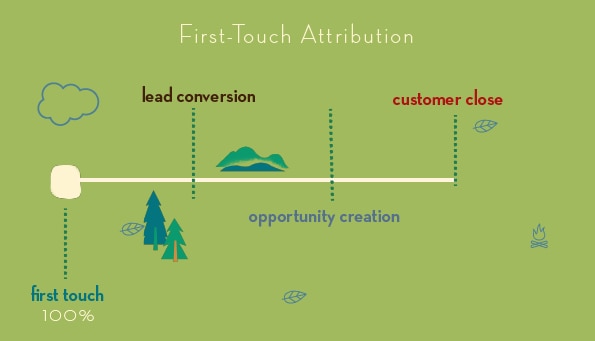Everything You Wanted to Know About Marketing Attribution Models (but Were Afraid to Ask)



One size doesn’t fit all when it comes to marketing attribution. Learn the basics of attribution, the available models, and which ones work best for your org.

Scott Rheinlander Rheinlander
Editor’s note: This article is among our most popular, so we’ve updated it recently to keep things fresh.
Marketers today have their work cut out for them. The average customer uses 10 channels to communicate with companies, which means the digital marketing landscape is more fragmented than ever. As customers’ expectations rise, so does the temperature in the proverbial kitchen for marketing management.
Research shows that marketers’ top priorities include optimizing the marketing mix for the best return and modernizing their tools and technologies. These teams are also revamping their marketing metrics for a new era. The same survey shows that 41% of marketing organizations are using marketing attribution modeling (e.g. marketing mix modeling, multi-touch attribution) as a measure of ROI.
So what are the most common types of marketing attribution? Whether you’re looking for an introduction to marketing or just brushing up on definitions, we’ve compiled this overview of marketing attribution models as a guide.
What is marketing attribution?
Marketing attribution is the way in which marketers assess the value or ROI of the channels that connect them to potential customers. In other words, it’s the means by which the customer came to know and buy your product or service.
It seems simple enough when you think about the final sale. But does a customer ever go straight to a website and make a purchase? Rarely. Multiple channels and messages were responsible for the final buying decision, including the Facebook ad they initially clicked on or the email they received when they signed up for the newsletter. In an ideal world, you’d be able to track the entire customer journey from start to finish with personal anecdotes from each customer about why they made the decisions they did along the way. But that’s not realistic, or scalable.
With so many touchpoints to consider, operational marketing roles are becoming more and more complex. Luckily, there are a number of marketing attribution models that have been introduced and evolved since the digital boom to account for multi-channel selling.
What are some common marketing attribution models?
Let’s take a closer look at these types of attribution models:
- First-touch attribution
- Last-touch attribution
- Multi-source attribution (several varieties explained below)
- Weighted multi-source attribution
There are many different approaches to marketing attribution that range from basic, single-factor models to advanced models, which can incorporate complex algorithms and logic. But every method of attribution has its pros and cons — making it one of the most hotly contested areas of marketing today.
1. What is single source marketing attribution?
Single source attribution models assign all the credit to one touchpoint, usually first touch or last touch.
- First-touch attribution. First-touch attribution assigns all the credit to the first channel the lead engaged with. For example, this might include a downloaded resource like a datasheet. While easy to implement (by simply tagging the lead source and attributing it to the final conversion), first touch marketing attribution fails to account for any customer interactions after the initial touch, altering the perceived effectiveness of other channels.
- Last-touch attribution. Because it’s the last touchpoint before the final sale, identifying where to give credit is relatively easy using the last touch model. In practice, this might be a final pitch deck or sales call. But it doesn’t account for any prior interactions (like the prospect’s website visits or interactions with the lead qualification team), missing out on key insights about other valuable marketing channels.

There’s no shortage of marketing channels to engage with customers today and lead to the final sale. It’s for this reason that single-source attribution is widely considered archaic and inaccurate.
2. What is multi-source marketing attribution?
In the multi-touch attribution (MTA) model, each contributing channel is given credit for contributing to the final conversion. Since MTA accounts for the entirety of a customer’s journey, attribution is given to multiple touchpoints, which could include everything from ads (whether one or 12) and social posts to webinars and e-newsletters. Yet despite being a more impartial method, MTA fails to account for each channel’s actual portion of contribution in addition to being complex to implement. There are six MTA models, including:
- Linear. The simplest MTA model, linear attribution gives equal weight and revenue credit to all touchpoints.
- Time decay. The lengthier the sales cycle (think B2B), the more spread out the touchpoints. The time decay model gives credit to more recent marketing touchpoints as opposed to those earlier in the process, which may not have been as impactful.
- U-shaped. The U-shaped MTA model gives credit to two key touchpoints — the first touch and the lead creation — and any in between. Forty percent of the credit goes to the first touch and 40% goes to lead creation, while the remaining 20% is divided between any touches that occurred in the middle.
- W-shaped. You guessed it. This model is the same as U-shaped MTA, except it includes an additional touchpoint — the opportunity creation. All three touchpoints receive 30% of the credit, while the remaining middle touches share 10%.
- Full path. Full path attribution builds on the W-shaped model, including the final close. Basically, the bulk of the credit is given to the major milestones of the customer journey, but lower weight is also assigned to the touchpoints in between. One of the biggest benefits of this model is that it accounts for the sales team’s post-opportunity follow-up interactions, giving them the same weight as early-stage marketing activities.
- Custom. Of course, there is an option to assign your own attribution weights through a custom model. Arguably the most sophisticated attribution model, custom methods allow teams to determine weighting percentages based on the industry, marketing channels used, and typical buyer behavior.

3. What is weighted multi-source attribution?
These models allow you to account for all interactions throughout the sales cycle with the added detail of weighting the touchpoints that did the heaviest lifting. Though it creates the most accurate depiction of the customer journey, weighted attribution models are extremely difficult to apply.
Weighted touchpoint modeling assigns a percentage of the revenue credit for a customer to an array touchpoints, as defined by the respective multi-touch attribution model chosen by the organization.
Which model is best? That’s the question that has marketers across the globe scratching their heads. But in general, the success of each model depends on the company. Various tools and good old-fashioned trial and error can help you compare marketing attribution models for the best outcome within your organization.
Consider this — whichever touchpoint you attribute value to will continually be budgeted for and supported by the business to keep performance high, making upstream channels suffer from perceived lack of effectiveness. With multi-channel attribution techniques, you can show value across all worthwhile channels, possibly persuading your budget keepers to allocate more funds.
What’s the role of attribution modeling across the business?
Despite the term “marketing attribution,” today’s multi-faceted approach to branding, campaigns, and customer experience has made it an enterprise-wide affair, especially when applying more complex models. Successful implementation of multi-touch and weighted multi-touch attribution models may take the participation of IT, while finance teams will want to be involved in the goal-setting and ROI portions of the program.
The same integrated mindset goes for CRM. Multi-touch attribution programs that integrate your company’s CRM stand to gain by sending attribution data directly into the sales machine. Together, sales and marketing can rely on the same tool to track, monitor, and report on the performance and strategy of their campaigns. Without it, the data you collect remains siloed from the rest of the organization, making it much harder to apply to future campaigns for optimization.
However, as marketing attribution moves to multi-touch models, this means businesses are measuring marketing touches that happen with existing contacts. These contacts are still considered prospects because they haven’t purchased yet, but since they already have a sales team assigned, they’re also not considered a new lead. What this means is that in an advanced multi-touch model, the business is measuring marketing’s influence on a prospect more than “sourcing” (finding a brand new opportunity for sales to pursue). The sticking point here is that sales teams historically only want to hear about what’s sourced, and not about marketing’s influence on prospects they’re already pursuing. It’s a continuing effort for marketing to convince sales that the biggest impact marketing can have on the business is more than just pure lead-based demand generation — it’s about strategically partnering with sales to mature and close deals faster than ever before.
How to get started with marketing attribution
As consumers explore new channels and companies adopt advancing marketing technologies, attribution becomes crucial to centering your entire marketing organization around a common goal of revenue generation. While the jury’s still out on the most successful marketing attribution models, tailoring your approach to the needs of your business — while keeping the data you collect integrated with your CRM and technology stack — will provide the biggest opportunities for lead conversion.
For more marketing articles, sign up for the 360 Highlights newsletter.























